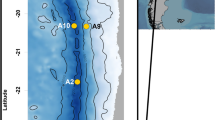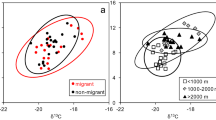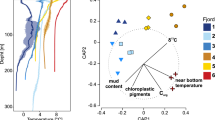Abstract
THE conventional notion of the deep-sea ecosystem has been one where a rain of fine organic particles from above provides food for a great diversity of small creatures living in and on the sediments1–3. These, the meiofauna and macrofauna, live as deposit feeders, suspension feeders, and, in lesser proportion, as carnivores preying on other members of the fauna. The macrofauna in turn are thought to provide food for the generally more carnivorous megafauna, the echinoderms, decapods, and fishes. Although no data have been published concerning the abundance of the deep-sea megafauna in terms of biomass, the assumed trophic relationship and the Eltonian concept has led to the common feeling that the biomass of this component must be small in comparison to the meiofaunal and macrofaunal biomass4. Our data show that, on the contrary, the mega-faunal biomass approaches that measured in the macro-fauna. This observation re-focuses attention on the question of food supply to the deep sea, and implies that previously suggested falls of large dead animals from the pelagial5,6 may be important.
This is a preview of subscription content, access via your institution
Access options
Subscribe to this journal
Receive 51 print issues and online access
$199.00 per year
only $3.90 per issue
Buy this article
- Purchase on Springer Link
- Instant access to full article PDF
Prices may be subject to local taxes which are calculated during checkout
Similar content being viewed by others
References
Marshall, N. B. Aspects of Deep-Sea Biology (Hutchinson, London 1954).
Menzies, R. J. Int. Rev. ges. Hydrobiol. 47, 339–345 (1962).
Hessler, R. R. in The Biology of the Oceanic Pacific (ed. Miller, C. B.) (Oregon State University Press, Corvallis, 1974).
Grassle, J. F. & Sanders, H. L. Deep-Sea Res. 20, 643–659 (1973).
Dayton, P. K. & Hessler, R. R. Deep-Sea Res. 19, 199–208 (1972).
Isaacs, J. D. & Schwartzlose, R. A. Sci. Am. 233, 85–91 (1975).
Rowe, G. T., Polloni, P. T. & Horner, S. G. Deep-Sea Res. 21, 641–650 (1974).
Smith, K. L. & Teal, J. Science 179, 282–283 (1973).
Wirsen, C. O. & Jannasch, H. W. Environ. Sci. Technol. 10, 880–886 (1976).
Haedrich, R. L. & Henderson, N. R. Deep-Sea Res. 21, 739–744 (1974).
Pearcy, W. G. & Ambler, J. W. Deep-Sea Res. 21, 745–759 (1974).
Hemmingsen, A. M. Rep. Steno Mem. Hosp. Nordisk Insulin Lab. 9, 1–110 (1960).
Bullis, H. & Struhsaker, P. Q. J. Florida Acad. Sci. 33, 43–76 (1970).
Wigley, R. L., Theroux, R. B. & Murray, H. E. Mar. Fish. Rev. 37, 1–(1975).
Thiel, H. Int. Rev. ges. Hydrobiol. 60, 575–606 (1975).
Grassle, J. F., Sanders, H. L., Hessler, R. R., Rowe, G. T. & McClellan, T. Deep-Sea Res. 22, 457–481 (1975).
Author information
Authors and Affiliations
Rights and permissions
About this article
Cite this article
HAEDRICH, R., ROWE, G. Megafaunal biomass in the deep sea. Nature 269, 141–142 (1977). https://doi.org/10.1038/269141a0
Received:
Accepted:
Published:
Issue Date:
DOI: https://doi.org/10.1038/269141a0
This article is cited by
-
Landscape-scale spatial heterogeneity in phytodetrital cover and megafauna biomass in the abyss links to modest topographic variation
Scientific Reports (2016)
-
Extraordinarily high biomass benthic community on Southern Ocean seamounts
Scientific Reports (2011)
-
Distribution patterns of five pleuronectid species on the continental slope off the Pacific coast of northern Honshu, Japan
Fisheries Science (2010)
-
A comparison of absorption and assimilation efficiencies between four species of shallow- and deep-living fishes
Marine Biology (2007)
Comments
By submitting a comment you agree to abide by our Terms and Community Guidelines. If you find something abusive or that does not comply with our terms or guidelines please flag it as inappropriate.



